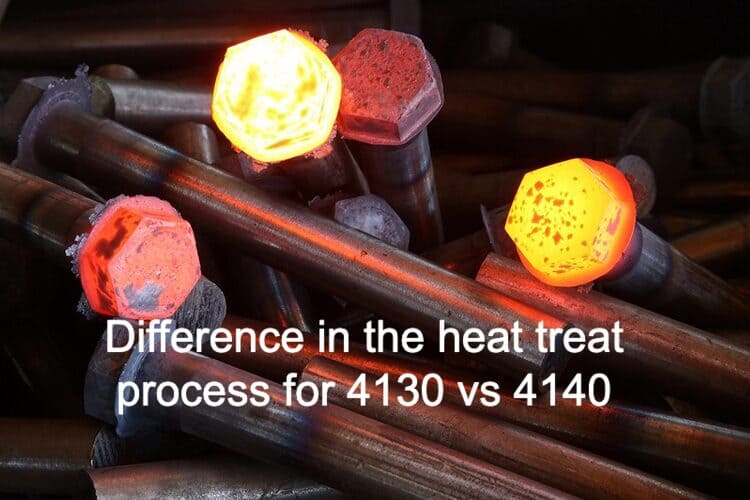The heat treatment processes for 4130 and 4140 steels differ in terms of the recommended heat treatment cycles and resulting material properties. Here’s a comparison of the heat treatment processes for these two alloy steels:

4130 Steel Heat Treatment
4130 steel is a low-alloy steel that has excellent strength-to-weight ratio and is commonly used in applications such as aerospace, automotive, and structural components.
The typical heat treatment process for 4130 steel involves:
Annealing
4130 steel is typically annealed to relieve internal stresses and improve machinability. The steel is heated to around 800-900°C (1470-1650°F) and then slowly cooled in a furnace to room temperature. This process is known as full annealing.
Normalizing
After annealing, the steel may undergo a normalizing process to refine the grain structure and improve uniformity. It involves heating the steel to around 870-925°C (1600-1700°F) and then air cooling.
Hardening
If higher strength and hardness are desired, 4130 steel can be hardened through a process known as oil quenching and tempering. The steel is heated to around 850-870°C (1560-1600°F), then quenched in oil to rapidly cool it.
Subsequently, the steel is tempered by reheating to a temperature between 480-620°C (900-1150°F) and then air cooling. This process helps achieve the desired combination of strength and toughness.
4140 Steel Heat Treatment
4140 steel is a versatile alloy steel widely used in applications such as gears, shafts, and structural components. The heat treatment process for 4140 steel typically involves:
Annealing
Similar to 4130 steel, annealing is carried out to relieve internal stresses and improve machinability. The steel is heated to around 800-850°C (1470-1560°F) and then slowly cooled in a furnace.
Quenching and Tempering
The primary heat treatment process for 4140 steel is quenching and tempering. After annealing, the steel is heated to the austenitizing temperature of approximately 815-845°C (1500-1550°F), followed by quenching in oil, water, or polymer to rapidly cool it. This results in a hardened structure.
After quenching, the steel is tempered by reheating to a temperature between 200-650°C (400-1200°F) to achieve the desired combination of hardness, strength, and toughness. The specific tempering temperature depends on the desired properties for the application.
Difference in the heat treat process for 4130 vs 4140
| Heat Treatment Process | 4130 Steel | 4140 Steel |
|---|---|---|
| Annealing | Full annealing: Heat to 800-900°C (1470-1650°F) and slowly cool to room temperature. | Annealing: Heat to 800-850°C (1470-1560°F) and slowly cool to room temperature. |
| Normalizing | Heating to 870-925°C (1600-1700°F) and air cooling. | Not typically required but can be performed similarly to 4130 steel. |
| Hardening | Oil quenching from 850-870°C (1560-1600°F), followed by tempering: Reheat to 480-620°C (900-1150°F) and air cooling. | Quenching in oil, water, or polymer from 815-845°C (1500-1550°F), followed by tempering: Reheat to 200-650°C (400-1200°F) for desired properties. |
| Tempering | Reheating to 480-620°C (900-1150°F) and air cooling for desired strength and toughness. | Reheating to 200-650°C (400-1200°F) for desired properties such as hardness, strength, and toughness. |
